

Beginning Innovationof
Henry Ford’s Plastic Car Made From Soybeans Unveiled in 1941. Page 14
SOYBEAN ASSOCIATION




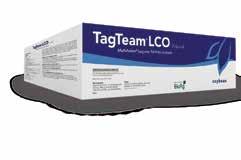




Tommie Price
Ohio Soybean Association Chairman Putnam County soybean farmer
Happy 50th Anniversary, Ohio Soybean Association!
2016 is here and with the New Year brings a huge milestone for the Ohio Soybean Association (OSA). This is the year OSA celebrates its 50th anniversary! A LOT has happened in the past 50 years, and to celebrate this important milestone, OSA will feature a series of in-depth articles that highlight soybeans, Ohio agriculture and OSA’s accomplishments over the years. The articles will cover highlights from the 1900’s through 2016 and then focus on what’s ahead. The first of six articles featured will showcase how soybean production took off in Ohio, and how growing interest in soybeans led to the creation of OSA and the American Soybean Association. The history behind it all is fascinating. According to the U.S. Department of Agriculture, Ohio farmers produced 230,000 bushels of soybeans in 1924. Today, Ohio soybean farmers are harvesting over 250 million bushels of soybeans. Moreover, soybeans play a large role in Ohio agriculture and will continue to do so.
In addition to OSA turning 50, the Ohio Soybean Council (OSC), the organization that manages soybean checkoff dollars, is celebrating its 25th anniversary. OSC highlights will also be incorporated in the series of articles. Speaking of which, the OSC 2015 investor report is also included in this magazine issue. Be sure to look through the report and see what OSA and OSC have accomplished this past year.
Hope you have a safe winter and best of luck as you prep for spring planting season.
SOYBEAN ASSOCIATION
President
Adam Graham, Logan County
First Vice
President
Todd Hesterman, Henry County
Vice President
Allen Armstrong, Clark County
Treasurer
Scott Metzger, Ross County
Secretary
Andy Stickel, Wood County
Chairman
Tommie Price, Putnam County
Trustees
Jerry Bambauer, Auglaize County
Amy Sigg Davis, Warren County
Bret Davis, Delaware County
Caitlyn Heimerl, Industry Affiliate Ex-Officio
James Heimerl, Licking County
Jerry Meyer, Industry Affiliate Cargill
Cindy Parker, Miami County
Derek Reusser, Holmes County
Ryan Rhoades, Marion County
Jeff Roehm, Highland County
Bruce Simmons, Medina County
Jeff Sollars, Fayette County
Jennifer Wilson, Van Wert County
Kerrick Wilson, Preble County
American Soybean Association
Board Representatives
Jerry Bambauer
Bret Davis
Jeff Sollars
Staff Credits
Adam Ward-Publisher
Jennifer Coleman-Editor
Katie Bauer-Contributing Editor/Staff Writer
Kayla Weaver-Contributing Writer
Donovan Harris-Design Director
Brent Warren-Senior Designer
Barry Falkner- Photo Quality/Proofer
Tony Green-Advertising Production
Ohio Soybean news is published six times a year by the Ohio Soybean Association, 918 Proprietors Rd., Suite A, Worthington, OH 43085. Phone: 614-476-3100. For address corrections contact Ohio Soybean News at 918 Proprietors Rd., Suite A, Worthington, OH 43085.
Web address: www.soyohio.org E-mail: cdeboard@soyohio.org
Comments and statewide news articles should be sent to the above address. Advertising space reservation must be made by the first of the month preceding publication. In consideration of the acceptance of advertisement, the agency and the advertiser must, in respect of the contents of the advertisement, indemnify and save the publisher harmless against any expense arising from claims or actions against the publisher because of the publication of the content of the advertisement.
For Advertising Sales Contact: Matt Herman- (612) 812-5833 matt.herman@dtn.com
Building Membership and Grassroots Advocacy
Congress Passes Tax Extenders, Omnibus
Congress concluded its work for the year by passing an omnibus appropriations bill and a package of tax provisions in a series of votes in December. Both pieces of legislation include items of significant interest and impact to soybean farmers, and below is a summary of the two bills. The House of Representatives passed the tax package by a vote of 318-108 and the Omnibus Appropriations bill by a vote of 316-113; and the Senate approved the package together with a vote of 65-33.
Tax Extenders Package
The Ohio Soybean Association (OSA) and American Soybean Association (ASA) had multiple priorities included in the Tax Extenders package, which passed with similar ease. The Protecting Americans from Tax Hikes (PATH) Act of 2015 included the following soy-specific provisions:
▶ Biodiesel Tax Credit — The package contains a two-year extension of the biodiesel tax credit. The credit is extended retroactive for 2015 and through 2016, however it remains as a blender’s credit rather than shifting to a producer’s credit as OSA, ASA and the biodiesel industry had supported.
▶ Section 179 Expensing Limits — The bill includes extension and modification of increased expensing limitations and treatment of certain real property as section 179 property. The provision permanently extends the small business expensing limitation and phase-out amounts in effect from 2010 to 2014 ($500,000 and $2 million, respectively). These amounts currently are $25,000 and $200,000, respectively. The provision modifies the expensing limitation by indexing both the $500,000 and $2 million limits for inflation beginning in 2016.
▶ Bonus Depreciation — The bill provides a 5 year extension of the bonus depreciation for property acquired and
placed in service during 2015 through 2019 (with an additional year for certain property with a longer production period). The bonus depreciation percentage is 50 percent for property placed in service during 2015, 2016 and 2017 and phases down, with 40 percent in 2018, and 30 percent in 2019. The provision also modifies bonus depreciation to include qualified improvement property and to permit certain trees, vines, and plants bearing fruit or nuts to be eligible for bonus depreciation when planted or grafted, rather than when placed in service.
▶ The package also extends the conservation easement tax credit, and tax credits for donations to ag research organizations.
Omnibus Appropriations Bill
While some media outlets suggested the future of the Omnibus Appropriations bill was less than certain in both the House and the Senate, the end result was anything but. The bill passed with 316 votes in the House and 65 in the Senate. Included in the bill are the following wins for soybean farmers:
▶ Repeal of the mandatory country of origin labeling (COOL) rule
▶ Increased funding for Agriculture Research Service (ARS) for salaries & expenses to $1.114 million, a $11.2 million increase; and for the ARS buildings & facilities account, $212.1 million, an increase of $167 million
▶ Increased funding for the National Institute of Food and Agriculture (NIFA) to $819.7 million, an increase of $32.8 million; including $350 million for the Agriculture and Food Research Initiative (AFRI), a $25 million increase
▶ Continued funding for the Market Access Program and Foreign Market Development (Cooperator) program at current levels of $200 million and $34.5

million, respectively
▶ Funding for the McGovern/Dole and Food for Peace development and assistance programs
▶ Funding for the Conservation Stewardship Program (CSP), which also helps to fund the Regional Conservation Partnership Programs (RCPP)
▶ Increased funding for the construction, operation and maintenance of projects administered by the Army Corps of Engineers along the Mississippi River and its tributaries
▶ $1.25 billion for eligible activities financed by the Harbor Maintenance Trust Fund, which funds port maintenance and improvements
▶ Dedicated funds for USDA disaster assistance programs, including those assisting growers suffering significant losses from recent flooding in the Carolinas. Unfortunately, two prominent — OSA and ASA — supported policy riders — one to prevent Environmental Protection Agency (EPA) from implementing the Waters of the U.S. (WOTUS) regulations and another on pre-emption of state GMO labeling initiatives — were on the table during negotiations over the omnibus, but ultimately were not included. Both issues are expected to be the focus of continued debate and legislative maneuvering again in 2016. u
Legislative and Regulatory Outlook for 2016
Prepared by the American Soybean Association

For a number of reasons, prospects for legislative and regulatory action in 2016 are relatively more predictable than in years past. First, it’s a Presidential election year, meaning Congress will adjourn in mid-July in advance of the nominating conventions, and then won’t consider any major legislation before the November elections. Any FY-2017 appropriations bills that aren’t done by July will wait for a lame duck session after the elections, and a short-term Continuing Resolution will need to be passed in September to keep the government running until then.
The shortened legislative session could also result in efforts to utilize the final
appropriations bills as vehicles for policy “riders” to address legislative priorities in 2016. However, most action will be regulatory, not legislative. The first few months of 2016 will see Executive Branch agencies propose and try to finalize every regulation they care about well before the elections. These could include the national dietary guidelines, changes to pesticide use labels as part of the President’s pollinator initiative and, hopefully, the Gulf of Mexico Fisheries Management Plan, to name just a few.
Second, the chances for a government shutdown over spending or a default on the national debt are negligible. The two-year budget deal reached
in September locked in the amount Congress will spend in FY-2017, an issue that closed the government in 2013. A second deal also reached in September will allow the federal debt ceiling to increase until April 2017, when a new President and Congress will have taken office. There is talk of trying to build a two-year budget, including FY-2018, into next year’s Budget Resolution while maintaining annual appropriations, which could provide some stability in the Congressional spending process.
Third, Congress and the Administration reached agreement on several key pieces of legislation before adjourning in December, so they won’t need to be
taken up again next year. These included a tax package which made several provisions permanent and extended others, such as bonus depreciation, for five years. The package also included a two-year extension of the biodiesel tax credit, which will now expire at the end of 2016. Given election year politics and the fact that several drivers of the perennial “tax extenders” package were renewed for five years or made permanent law, it will be more difficult to forge action on the tax credits that expire at the end of 2016. On the transportation and infrastructure front, Congress completed a five-year highway bill reauthorization this year, removing this issue from the 2016 agenda.
Also on the biodiesel front, while the EPA has set volume requirements for the biomass-based diesel category through 2017, they will be issuing proposals on volume requirements for the overall Advanced Biofuels category, which impacts biodiesel. The biodiesel industry and stakeholders will also be closely monitoring trade issues, particularly the potential for larger import volumes from Argentina.
Of the issues that remain, the stalemate between Republicans and the Administration over the WOTUS regulations promulgated by the EPA is almost certain to continue, leaving any possible resolution to the courts. Chances for a major tax reform package will be deferred to no earlier than the lame duck session, which will depend on the outcome of the elections. There will also be an attempt to restore the traditional two-year reauthorization schedule for the Water Resources Development Act (WRDA). However, any action would be small in scale and will focus on technical issues and implementation of reforms enacted in 2014.
Items on the agenda for the Agriculture Committees in 2016 include reauthorizations of school nutrition standards and the CFTC. There is also the unresolved and pressing issue of biotech food labeling, with the approaching implementation of
Vermont’s law in July and other states considering similar action. Secretary Vilsack has announced that he will bring food companies and consumer groups together starting in January in an effort to find common ground, but the endpoint of this process is difficult to foresee. ASA will push hard for Congressional action on legislation to establish voluntary federal standards to prevent a patchwork of state labeling requirements that would raise food costs and stigmatize foods containing biotech ingredients.
The Agriculture Committees are also likely to hold more hearings on the effectiveness of the Agricultural Act of 2014 and on priorities for the next farm bill. In addition, the cotton industry is looking for either the Administration or Congress to provide relief from low prices and the limited effectiveness of the STAX program in supporting producer income, a prospect that could require reopening the farm bill.
On the trade agenda, the Administration will need to decide whether to heed Senate Majority Leader McConnell’s warning to not submit the Trans-Pacific Partnership agreement for approval by Congress until after the elections. The Transatlantic Trade and Investment Partnership negotiations are unlikely to be completed by this Administration,
and decisions on issues important to U.S. agriculture, including the EU’s biotech approval process and Renewable Energy Directive requirements, are a long way from being resolved. While progress on further normalizing relations with Cuba are likely to be delayed until after the elections, efforts will continue to educate Members of Congress on the importance to U.S. agriculture of lifting the embargo.
Finally, just before years-end, we learned that Brazil’s soybean growers association, APROSOJA, has requested that their government consider filing a WTO case against the U.S. soybean crop insurance program. This issue could become a major focus of attention for ASA in 2016 and future years.
While the outlook for legislation and regulatory activity in 2016 that affect agriculture may now appear to be more predictable, no one should be surprised if and when issues that are not on the table suddenly become urgent priorities. The recent shift in public attention from income inequality to terrorism is only one example of how priorities can change, almost overnight. And with the hyper-politicized policy environment caused by the upcoming Presidential primary season and the approach of the general elections, the landscape for federal action can change many times before the end of next year. u

Bret Davis Re-elected to ASA Governing Committee
Bret Davis, Ohio soybean farmer from Delaware County was recently re-elected to the American Soybean Association (ASA) governing committee.
Davis is part of a nine-member governing committee that will help guide ASA and implement the policies aligned in the strategic plan. Davis is joined by Secretary John Heisdorffer from Keota, Iowa; and Kevin Hoyer of West Salem, Wisc., Kevin Scott of Valley Springs, S.D., and Sam Butler of New Hope, Ala.. Current Treasurer Davie Stephens of Wingo, Ky., was elected to serve a second term in the same position.
In addition to his role on ASA, Davis serves on both the Ohio Soybean Council and Ohio Soybean Association Board of Trustees. Davis holds a designation as a Certified Crop Advisor and is a past president of both the FSA Board and the Delaware County Farm
Bureau. He was a member of the FFA and earned his American FFA Degree. Richard Wilkins, a farmer from Greenwood, Del., assumes the role of president of ASA following his confirmation by the ASA Board of Directors at their annual winter meeting in St. Louis. Outgoing president Wade Cowan from Brownfield, Texas, moves to the position of chairman of the ASA board, and Ron Moore of Roseville, Ill., was elected to serve as vice president.
“I’m honored to serve on ASA’s Governing Committee with a great team of farmers,” said Davis. “It’s going to be a busy year and we have a great agenda ahead.”
Assuming positions on the Board as new members at the meeting are Charles Atkinson of Kansas, Cliff Barron of South Carolina, Ken Boswell of Nebraska, and Dean Coleman of Iowa. u
Bret Davis was re-elected to ASA’s Governing Committee. Davis is part on a nine-member governing committee that will help guide ASA and implement the policies aligned in the strategic plan.

New Conversion Calculator Now Available on USSEC.org
The U.S. Soybean Export Council (USSEC) has now made it easier to convert one unit of measurement to another. USSEC has launched a new conversion calculator which can be found at the top right corner of their website.
Many types of conversions can be made including:
▶ acres to hectares
▶ bushels per acre to kilograms per hectare
▶ miles to kilometers
▶ bushels of soybeans to metric tons (MT) of soybeans
▶ Fahrenheit to Celsius
The conversion calculator is easily accessible at the top right corner of the USSEC website. Visit USSEC.org for details.





Ohio soybean farmers consistently rank state and federal regulation as their top concern.
The Ohio Soybean Association (OSA) provides leadership for Ohio’s soybean farmers in promoting effective policies and legislation. OSA represents its members at both the state and federal levels, and works cooperatively with its national affiliate, the American Soybean Association. Soybean checkoff dollars cannot be used for lobbying and legislative activities. That’s why your OSA membership is vital to making the soybean industry in Ohio successful and profitable for years to come.






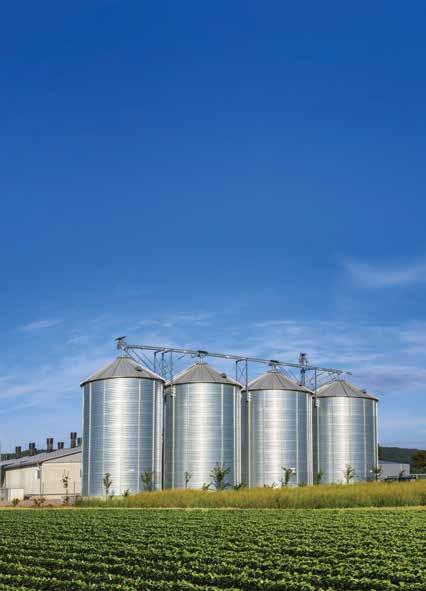
The Ohio Soybean Council was founded in 1991 to manage the Soybean Research and Promotion Program, commonly referred to as the soybean checkoff. Soybean farmers pay one half of one percent of the bushel price to the soybean checkoff when they sell soybeans. Half is sent to the United Soybean Board and half is invested right here in Ohio in soybean production research, marketing and promotion, new product development and education to maximize profit opportunities for soybean farmers.
To learn more, visit soyohio.org/membership. To learn more, visit soyohio.org/checkoff.
Building Membership and Grassroots Advocacy
Seed Treatments Valuable Tool for Ohio Farmers
Alot of little factors go into having a successful crop with farmers making many decisions for spring planting long before the seeds meet the soil. Before harvest is even finished, farmers are evaluating yield data, collecting soil samples and considering the seed and chemicals they will use next spring. Those decisions have to count: Because a farmer may hope for an ideal growing season, but when it comes to the weather, mother nature has the final say.
The seed itself plays an important role, and the traits it contains can provide some built-in resistance, however, many Ohio farmers are finding it pays to have some extra help waiting in the wings in the form of a seed treatment. Seed is already an expensive input for farmers and adding a treatment raises that cost, but when considering the alternative is the potential for severe yield loss, a seed treatment is an attractive option.
“Seed treatments are like an insurance package for whatever conditions might occur after you put that seed in the ground,” said Anne Dorrance, professor and soybean pathologist at The Ohio State University. “The value was especially evident in our western counties in
Many varieties of seed treatments contain residuals which last up to a month after planting to protect seedlings until they emerge.

2015 where disease pressure was severe with constant heavy rains over a three to four-week period.”
If conditions are right — the ground is well drained, crops are grown in rotation, and fields are lightly tilled — it may be hard to find the value of a seed treatment. The real benefit of a treatment becomes evident when conditions are more severe — heavy clay soils, continuous soybeans, and no-till practices — where the inoculum builds in the top layers.
Seed treatments have come a long way in the last five years and typically encompass a more comprehensive solution to issues producers encounter in less than ideal field conditions. Nearly all seed treatments contain at least one insecticide and several fungicides, but the exact formulations vary widely.
“In Ohio, we have a pretty large number of fungi and different water molds that attacks seeds and young seedlings, which the treatments provide excellent protection against,” said Dorrance. “We’ve seen over the years with the water molds certain fungicides are not effective alone. That’s why now we’re seeing the multi-component treatments.”
In a seed treatment with multiple components, one material will hit some of the water molds, another material will protect against others and there may be one more for true fungi like Rhizoctonia and Fusarium. With a comprehensive formula, a seed treatment can cover most everything that may affect the field.
While there are a few smaller companies with somewhat older technology that will mix and match materials, many companies sell their treatments as proprietary mixes that are only available to growers as a prescription for a certain seed variety. When considering seed selection and treatments growers need to know their soil types and consider field characteristics and disease prevalence in the area.
Dorrance recommends growers in Ohio look for Metalaxyl or Mefenoxam as a highly effective measure against phytophthora sojae as well as many other water molds. Soybean cyst nematode resistance is another important factor, and while many commercial seed varieties now have resistance built in, some areas are more susceptible and growers dealing with sandy soils may benefit from extra precautions.
The residual power of a seed treatment should also be a top of mind consideration. One complex may cost less, but that price difference is often correlated to a performance feature.
“Especially in northwest Ohio, growers want to have the best field resistance or partial resistance that’s available. Some of the companies call it tolerance because the seed treatment is only going to give them about a two to three-week protection until that plant is up and growing, and then the post plant resistance is going to take it from there,” said Dorrance.
An additional pathogen that producers may not be used to looking for is brown stem rot. While its presence has been established in Ohio, producers rarely see any symptoms. However, research in Wisconsin has found a clear correlation of brown stem rot and low soil pH with the lower the soil pH, the greater the severity of the symptoms and higher potential of yield loss. A recent survey in Ohio has picked up field data from soils with a pH around 5, which is an indicator that a producer should also look at the brown stem rot score.
Seed treatments are a great tool for producers, but they are only one piece of the puzzle. When a producer knows their soil type and characteristics they are better able to identify the strengths and weaknesses, the pests and pathogens in the area they are susceptible to and will find it easier to determine the right seed traits and seed treatments to maximize their plant health and ultimately their yields. u

The Ohio Soybean Council (OSC) and soybean checkoff are working with scientists at The Ohio State University and Extension to find new and better ways to manage insects, diseases, weeds, nutrients and water quality all while maintaining your profitability. It can be challenging, however, to stay on top of everything. Soybean Rewards is a program developed by OSC to help keep the flow of information between farmers and researchers moving. To see how, visit soybeanrewards.org
Brought to you by Ohio soybean farmers and their checkoff.
YOU DON’T HAVE TO DIG DEEP TO SEE HOW SOYBEAN RESEARCH HAS BENEFITTED OHIO FARMERS.
Building Membership and Grassroots Advocacy

2 0 1 5 B e c k ’ s Y o u n g F a r m L e a d e r o f t h e Y e a r


C o n g r a t u l a t i o n s R y a n M c C l u r e o f P a u l d in g C o u n t y !
R y a n w a s c h o s e n a s t h e 2 0 1 5 B e c k ’ s Y o u n g F a r m L e a d e r
o f t h e Y e a r a n d w i l l r e c e i v e a t r ip f o r t w o t o t h e
2 0 1 6 C o mm o d i t y C l a s s i c i n N e w O r l e a n s , L o u i s ia n a . Y O U c o u l d b e n e x t .
A s t h e a v e r a g e a g e o f t h e
A m e r i c a n f a r m e r i n c r e a s e s , i t
b e c o m e s m o r e i m p e r a t i v e t h a t n e w
y o u n g p e o p l e s t e p u p a n d s t e p i n t o
t h e r o l e o f p r o v i d i n g f o o d f o r a n
e v e r g r o w i n g p o p u l a t i o n
I n P a u l d i n g C o u n t y , R y a n M c C l u r e
r e c o g n i z e s t h a t n e e d a n d h a s
b e c o m e a n i n t e g r a l p a r t o f h i s f a m i -
l y ’ s f a r m i n g o p e r a t i o n a s w e l l a s a n
a d v o c a t e f o r t h e i n d u s t r y
M c C l u r e F a r m s w a s s t a r t e d b y
R y a n ’ s g r a n d f a t h e r i n 1 9 5 5 a n d h a s
be e n a f a m i l y t r a d i t i o n e v e r s i n c e
R y a n g r e w u p f a r m i n g a l o n g s i d e h i s
f a t h e r , T e r r y M c C l u r e , a n d t h e
t h o u g h t o f m a k i n g a c a r e e r d o i n g
a n y t h i n g e l s e n e v e r c r o s s e d h i s m i n d
“ I t ’ s t h e o n l y t h i n g I k n o w , f r o m
t h e t i m e I w a s y o u n g , t h a t w a s w h a t
w e d i d ; w e f a r m e d I f w e w e r e n ’ t i n
s c h o o l o r d o i n g c h o r e s a t h o m e , w e
w e r e f a r m i n g , ” s a i d R y a
Ryan currently serves as a director on the Ohio Pork Council and as the Paulding County Farm Bureau President He and Nikki have been active in the Ohio Farm Bureau for many years and served a two-year term on the American Farm Bureau Federation’s Young Farmer and Rancher committee They’re also active members of Middle Creek United Methodist Church
T h e 2 0 1 6 B e c k ’ s Y o u n g F a r m L e a d e r a p p l i c a t i o n s a r e n o w a v a i l a b l e !
A p p l y o r No m i na te S o m e o n e T o d a y !
T h e B e c k’ s Y o u n g F a r m Le a d e r P ro g ra m w a s e s t a b l i s h e d t o hi g h l i g h t y o u n g O hi o fa rm e r s
w h o h a v e t a k e n l e a d e rs hi p r o l e s i n t he i r c o m m u n i t i e s w h i l e d e v e l o p i n g a f o u nd a t i o n fo r fa rm i ng s u c c e s s.
B e c k ’ s Y o u n g F a r m L e a d e r A p p l i c a t io n G u i d e l i n e s :
• Gr o w er s mu s t b e b e t w e e n t h e a g es o f 2 1 a n d 45
• A n y s o y b ea n g r o w e r m a y a p p l y f or t h e p r og r a m ; s e l e c t e d p a r t i c i p a n t s a r e r e q u i r e d t o h a v e a c u r r e n t Oh i o
So y b e a n A s s o c i a t i o n me m b e rs h i p
• A p p l i c a n t s a re n o t r e q u i r e d t o g r ow B e c k ’s H y b r i d s p r o d u c t s t o b e e l i g i b l e t o w i n
• A p p l i c a n t s s h ou l d d em o n s t r a t e a n i n t e r e s t i n p u r s u i n g l e a d e r s h i p r ol e s w i t h i n t h e s o y b ea n i n d u s t r y
To a p p l y or n o mi n a t e s om eo n e , v i s i t w w w s oy o h i o o rg / b e c ks y o u n g f a r m l e a d e r
Ryan and Nikki McClure are part of the third generation to operate McClure farms, and they are hoping the fourth generation will include their children Caleb, Drew and Brianna
Building Membership and Grassroots Advocacy
Free Mobile App Helps Farmers Comply with New State Laws
Afree mobile app is now available to help farmers comply with new recordkeeping requirements created under two state laws.
Developed by Knox County Farm Bureau and Knox County Soil and Water Conservation District, the Ohio Nutrient Management Record Keeper (ONMRK) was designed to help farmers comply with Senate Bill 1, which restricts the application of manure and fertilizer on frozen, snow-covered or saturated ground in the Western Lake Erie Basin, and Senate Bill 150, which requires anyone who applies fertilizer on more than 50 acres to obtain fertilizer application certification. The app is available at www.onmrk.com , Google Play and the App Store.
Over $30,000 in grant money for the development of the app was awarded through Ohio Farm Bureau’s County Water Quality Initiative Program, Ohio State University Extension and the Muskingum Watershed Conservancy District.
The ONMRK app features dropdown menus that make it easy and quick for farmers to record their fertilizer or manure application as well as record the current weather conditions and forecast for the next 24 hours. Those records can then be printed through an Internet portal.
“We wanted to make it simple and not have farmers be at the edge of the field and entering a lot of data,” said Knox County Farm Bureau President Trish Levering. “It was very important for us to team up with the local Soil and Water Conservation District on a project like this that has an impact
locally and statewide. It’s going to take a lot of people working together to improve our water quality situation here in Ohio.”
After setting up the ONMRK app on their mobile device, farmers can easily record what nutrients they apply on their farms and fields. The application screen shows the current weather and the weather forecast. If the weather forecast calls for more than ½ inch of rain, there will be a warning, letting farmers know their application could be out of compliance. The application information is quickly entered in drop-down menus that track type, time, analysis, soil conditions, method of application, field conditions and amount of nutrients applied per acre and any notes to be included in the report. All the information is saved, and application reports can be downloaded for printing from the Web portal.
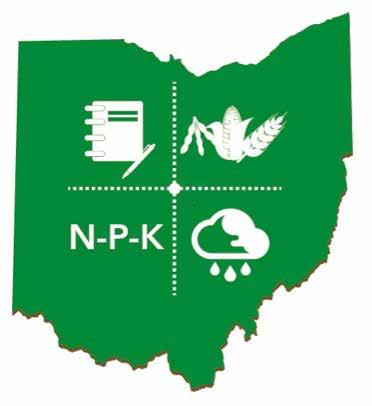
Over $30,000 in grant money was awarded through Ohio Farm Bureau’s County Water Quality Initiative Program, Ohio State University Extension and the Muskingum Watershed Conservancy District to develop the app to help farmers comply with new recordkeeping requirements created under two state laws.
The project was one of 12 county Farm Bureau projects funded by Ohio Farm Bureau this year as part of its $1 million Water Quality Action Plan. Ohio Farm Bureau provided nearly $140,000 in direct support to the county Farm Bureau water quality projects with partnering organizations providing additional matching funds. u
Innovation Leads to Long-Time Ohio Soybean Success
Soybeans have been grown in Ohio as an annual crop since the 1890s. And as much as times have changed during the last century or so, some things have remained the same. That includes a focus on innovation and a commitment to soybean profitability that continues to energize the longterm capabilities and promise of the state’s soybean industry.
The year 2016 marks the 25th anniversary of the Ohio Soybean Council (OSC) and soybean checkoff and the 50th anniversary of the Ohio Soybean Association (OSA).
OSA was founded in 1966 to provide leadership for Ohio soybean farmers in promoting effective policies and legislation to ensure a growing and profitable soybean industry.
Since 1991, OSC’s vision has been to assure the long-term viability of Ohio soybeans farmers. OSC invests soybean checkoff funds to maximize farmer profit opportunities.
To commemorate both anniversaries, the next six issues of Ohio Soybean News will publish a special series that recounts the story of soybeans in the U.S. and Ohio, as well as reflects on the notable moments in the history of OSA and OSC.
Soybeans Find Their Way to Ohio

Ohio in the early 1900s was a home for innovators. Harry M. Stevens created the first hot dog in 1900, and the Wright Brothers from Dayton invented the airplane in 1903. Cleveland got the nation’s first traffic light in 1914, while Roy J. Plunkett of New Carlisle first crafted Teflon in 1938.
Innovation also was taking place in the countryside. The Ohio State University was founded in 1870 as a land-grant university, originally known as the Ohio Agricultural and Mechanical College. But it wasn’t until
Carver famously loved his lab on Tuskegee’s campus. Once the honored guest at a parade in Atlantic City, N.J., he is quoted as saying he would have been happier in his lab doing real work than observing the parade.
1914 that the Smith-Lever Act created the Extension Service, and expanded vocational, agricultural and home demonstration programs. Fifteen years later, the Capper-Ketchum Act provided funding for states to add county agents and open the doors to even greater research and opportunity.
According to the 1882 Ohio Ag Experiment Station (OAES) annual report, soybeans were grown in the state for green chop and green manure. Subsequent Extension bulletins show soybeans became an annual crop by 1892, with a total of 14 acres of
SOYBEAN ASSOCIATION
soybeans planted in the state in 1904.
In 1900, Extension recommended solid seeding the crop for forage and use as a replacement for clover. In 1908, OAES received two dozen strains of soybeans for evaluation from William Morse, a USDA specialist who was considered the father of soybeans and helped create the American Soybean Association (ASA). In 1916 there were 4,921 acres of soybeans in Ohio. By 1923, some 128,000 acres were grown as a hay crop.
In 1923 steel industrialist Gordon Battelle made arrangements to leave his fortune to help establish the Battelle Memorial Institute. It was founded in 1929 with headquarters in Columbus. The institute’s mission is to translate scientific discovery and technology advances into societal benefits, and OSC’s work with the group in more recent years has helped Ohio farmers find new uses for their soybeans.
Early soybeans presented production challenges. Gold, green, black, brown and mottled seeds grew as ground vines or leggy stalks while harvest was difficult because pods shattered easily.
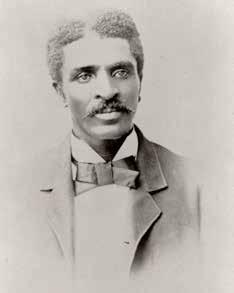
Original Foundation. OAES released its first soybean varieties from four unspecified seed selections in 1916. Ohio Extension bulletins report the variety Hamilton was selected in 1909. The variety was named in 1922, but historians speculate it may have been one of the original four.
Above: George Washington Carver’s graduation photo.
Below: Robert Boyer and Henry Ford unveiling the “Soybean Car” in 1941.

Wing Seed Co. first started selling soybeans in 1909. John Wing of Irwin sold the first private variety in the state in 1925. It was called Wing Jet.
Extension bulletins say most varieties grown in Ohio today are descendants of six yellow-seeded varieties selected for the light-colored oil they produced. Manchu and Manchuria and seed selections from both of those varieties were popular by 1923. Scioto and Mingo were varieties selected from Manchu and released by OAES in the mid-1930s.
Soybean production expansion took off during the 1940s, as hybridization breeding further developed soybean varieties. Ohio soybean yields went from 11.5 bushels per acre in 1924 to 16 bushels in 1940. Ohio farmers produced 230,000 bushels of soybeans in 1924, the first USDA estimate, and nearly nine million bushels by 1940.
Amy Sigg Davis, soybean farmer from Warren County and OSA board member, remembers some of the early soybeans grown in the state beginning in the 1950s. She recalls riding the tractor and threshing soybeans with her father. “We grew some of the first soybeans in the area. My dad was a trendsetter, and he was convinced soybeans would be a crop that would change things for Ohio farmers,” she remembers. “Soybeans were, and are, a successful crop, and we have raised them ever since.”
More Than Hay. As farmers in Ohio were experimenting with soybeans as hay crops, George Washington Carver at Tuskegee Institute in Alabama was experimenting with other ways to use soybeans. According to his bio posted by the university, Carver wanted to develop practical farming methods to grow protein-rich soybeans and peanuts to eliminate continuous cotton production.
Carver had discovered nutrientdepleted soils could be revitalized with legumes, so he began to advocate crop rotation. His research into
PHOTO: IOWA STATE UNIVERSITY LIBRARY

soybean product development led to what remain the crop’s two main uses today — edible oil and protein meal. Carver is credited for developing more than 300 soybean by-products for plastics, paints, fuels and food substitutes.
“I am an advocate for the diversity of uses that come from soybeans,” says Davis. “We haven’t even begun to realize all the things we can do and products we can make with them.”
Soybean research remains a crucial pathway to profitability for Ohio farmers. Projects underway today at The Ohio State University address genetics, insect and disease resistance, nutrient management and water quality, and represent 20% of the Ohio soybean checkoff’s annual budget.
Industrial Innovation . Carver wasn’t alone in his pursuit of innovative soybean uses. He coordinated some of his work with Henry Ford. The automobile manufacturer was looking for a project in the early 1900s that would combine industry with agriculture. There was a shortage of
Investing Checkoff Dollars
metal at the time, and Ford hoped a new plastic material might replace the traditional metals used in cars.
Ford asked Lowell E. Overly, a tool and die design specialist at the Soybean Laboratory in Greenfield Village to work with his supervisor and chemist, Robert A. Boyer, to devise a plan for using crops in car production. The pair developed a chemical formula for plastics that’s believed to include soybeans, wheat, hemp, flax and ramie. No record of the formula exists. Ford museum history says Overly described the material as, “soybean fiber in a phenolic resin with formaldehyde used in the impregnation” to create a “soybean car.”
Henry Ford unveiled the car in 1941. The frame was made of steel and had 14 panels made from the soybean plastic attached to it. Ford claimed the plastic panels made the car safer than traditional steel cars; and that the car could roll over without being crushed. While the idea may have had merit, World War II suspended the plastic car experiment.
Soybean plastics and other product innovations have continued, and even today play a role in building demand for Ohio soybeans.
“Soybeans continue to play a huge role in Ohio agriculture. Soybean checkoff-funded research has increased our yields and improved our soybean quality, as well as helped us develop new markets and uses,” says Davis. “We have had tremendous success with improvements over the years and I am confident we also will be able to meet the needs of the future.”
War Time Transition . It wasn’t until the 1940s that soybean farming really took off in the United States. Soybean production in China, which was then the major world supplier, halted with World War II and the country’s domestic revolution. When the U.S. entered the war, greater demand for oils, lubricants, plastics and other products fueled soybean demand — a demand that U.S. farmers were more than willing to fill. Learn more in the next issue of Ohio Soybean News u
Growing Interest Leads To Creation Of National Soybean Growers’ Association
Farmers in Ohio were not the only ones experimenting with soybeans in the early 1900s. Taylor, Finis and Noah Fouts, in Camden, Ind., had obtained seed from the Indiana Experiment Station and planted four acres in 1904. By 1907, the Fouts had 200 bushels of seed soybeans. So strong was their commitment, their farming operation was officially named “Soyland” in 1918. Soyland hosted the first Corn Belt Soybean Field Day in 1920. About 1,000 interested farmers from surrounding states, including Ohio, attended. By the end of the event, farmers had formed a national organization named the National Soybean Growers’ Association.
The organization’s name was changed to American Soybean Association (ASA) in 1925 to focus on grassroots advocacy for the nation’s soybean farmers. ASA quickly celebrated a major legislative victory when it helped get a tariff levied on lowcost, imported soybean cake and meal in 1928. ASA helped to enact a stronger protective tariff for soybeans, oil and meal in 1930. In 1940, ASA established headquarters in Hudson, Iowa, where it stayed until 1978, relocating to St. Louis, Mo.
During the early ASA years, several Ohioans took the leadership helm. Past presidents include:

J.B. Park, 1937–38 Columbus, Ohio


G.G. McIlroy, 1938–41 Irwin, Ohio
David G. Wing, 1941–43 Mechanicsburg, Ohio
In the late 1940s, ASA representatives began traveling regularly to foreign countries seeking new markets for U.S. soybeans, oil and meal. The trips led to establishing the first ASA overseas office in 1956 in Tokyo, Japan. By 1984, ASA had 11 international offices. In the years that followed, OSC has worked with ASA and now the U.S. Soybean Export Council (USSEC) to promote U.S. soybeans and to provide technical training to overseas customers buying U.S. soy.

John Motter Elected Vice Chair of USB
The United Soybean Board (USB) recently elected executive committee members to lead the national soybean checkoff in 2016. John Motter, Ohio soybean farmer and Ohio Soybean Council (OSC) board member from Hancock County was elected as Vice Chair.
USB consists of 70 farmer-directors that oversee the investments of the national soybean checkoff to maximize profit opportunities for all U.S. soybean farmers. These volunteers invest and leverage checkoff funds to increase the value of U.S. soybean meal and oil, ensure U.S. soybean farmers and their customers have the freedom and
infrastructure to operate, and meet the needs of U.S. soybeans’s customers.
Prior to being elected as Vice Chair, Motter served as the treasurer for USB. In addition to his involvement with USB and OSC, John is a member of Ohio Farm Bureau and previously served on the State Extension Advisory Board. John has held office on the Hancock County Fair Board and is a member and elder of the Emmanuel

United Church of Christ. Motter will work alongside Jared Hagert, soybean farmer from Emerado, North Dakota who has been elected by his fellow USB farmer-directors as chair. USB will implement a new long-range strategic plan, which emphasizes soybean innovation for farmer profit opportunities, including continued high oleic development, soybean-meal-quality improvements and technological advances to maximize on-farm profitability. u
Ohio Soybean Council Elects Officers for 2015–2016
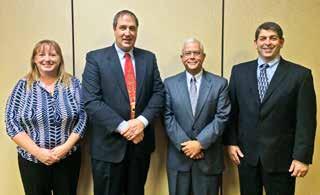
From left to right: Gretchen Mossbarger, Steve Reinhard, Terry McClure and Bill Bateson were recently elected as OSC officers.
The Ohio Soybean Council (OSC) Board of Trustees elected officers for 2015-2016 during the December board meeting. These executive committee positions include the offices of chairman, vice chairman, treasurer and secretary.
Individuals in these positions are responsible for the implementation of board policies and procedures, as well as carrying out the roles for their
respective offices. Terry McClure of Paulding County was elected chairman.
McClure previously served as OSC vice chairman and a Soy Transportation Coalition board member. In addition to his volunteer leadership position with OSC, McClure is a member of the Board of Directors of Nationwide Mutual Insurance Company. Previously McClure was president of the Ohio Farm Bureau Federation, a board member of the Ohio Small Grains Marketing Program, and a board member of the Paulding County Soil and Water Conservation District. He farms soybeans, corn, wheat and raises hogs.
Elected vice-chairman after holding the office of treasurer was Steve Reinhard. Reinhard farms soybeans, corn and wheat in Crawford County. He earned a B.S. from The Ohio State University in Agricultural Economics and Agricultural Education. Reinhard is active in many agricultural groups
including Ohio Farm Bureau Federation and the Crawford County Soil & Water Conservation District. He is a member of the Bucyrus Chamber of Commerce and Martin Luther Lutheran Church and also serves as a volunteer firefighter.
The board elected Bill Bateson of Hancock County to his first term on the executive committee as treasurer. Bateson produces soybeans, corn and wheat. In addition to being a grain farmer, he raises beef cattle and manages 30 cows in a cow to calf operation. Outside of agriculture, Bill is a member of Good Hope Church and coaches the junior high basketball team.
Gretchen Mossbarger of Ross County was elected to her second term as secretary. Mossbarger farms in Pickaway and Franklin Counties in Ohio on R Farm. She grows field corn and produces soybean and wheat seed for retail sales and serves on the board for the Ohio Seed Improvement Association. Gretchen is also a member of The Ohio State University Alumni Association, Frankfort United Methodist Church and Ohio Farm Bureau Federation. u
John Motter


California’s Water Battle Puts Agriculture on the Front Line
Most anyone reading this will be very familiar with Ohio’s water woes — there is too much then too little, too many nutrients in lakes and streams, and toxic algae results. While the challenges with water in Ohio are significant, they are not unique and represent only a small fraction of the daunting water challenges being dealt with around the country. The issues of water quality and supply are monumental and will not be going away any time soon. Water could very well be the defining challenge in the current era of agriculture.
With this in mind, a series of stories over the next few months will be taking a look at the some of the nation’s water issues. What better place to start than California?
When the 2016 water year began on Oct. 1, water storage in California’s federal Central Valley Project was at 47% of the 15-year average, about 200,000 acre-feet less than last year at the same time. With California in the midst of one of its worst droughts in history, the vital agricultural industry in the state is paying a heavy price to maintain production and conserve valuable water.
but we can apply water when we need it and we have the warm temperatures to grow the myriad of crops we do.”
The system has worked well for years to allow for incredible agricultural production, but the major drought has put tremendous strain on the state’s water resources required to support agriculture and the state’s large population.
“We have not really grown our water infrastructure in 40 years while our population has grown from 20 million to almost 40 million,” Wenger said.
inches of water to apply to our fields. For our almonds and walnuts in a normal year we require 30 and 36 inches of applied water. If we are going to irrigate a corn crop or alfalfa we would also use around 30 or 36 inches depending on the soil type. As you go further down the valley, that water demand goes up because of the heat. It could be 50% higher for the amount of water needed.”
In response to the necessary water use reductions, Wenger and other farmers are employing new water management practices.

Paul Wenger, president of the California Farm Bureau
“The water issues result in more expense and more management. Growers have gotten into microirrigation. They are using drip lines and spoon-feeding the amount of water that goes onto the plants. We are seeing things like strawberries grown on subterranean drip lines,” Wenger said. “But what we are seeing is that we are not recharging the underground aquifers. Before when we used less efficient irrigation techniques, our plants would grab 30, 40 or 50% of the water applied and the water that wasn’t used by the plants helped fill the underground aquifer.”
“It is all interrelated with different nuances in every part of the country. Water supply for us right now is the major issue,” said Paul Wenger, president of the California Farm Bureau. “In California we are unique because we have always been able to store water. We have the Pacific Ocean on one side and the Sierra Nevada on the other and that allows us to have mountain reservoirs for snow capture and runoff. Typically, 70% of our water comes from snowmelt that fills our reservoirs and underground aquifers. We are one of a few Mediterranean regions in the world and we have an arid climate,
Wenger produces almonds and walnuts on his central California farm and has seen dramatic water use reduction for his crops.
“We are seeing a 60% reduction in the water allotment of surface water from what we had last year. We own a reservoir in the Modesto Irrigation District in combination with the Turlock, which is the town just south of us. We’ve always had ample amounts of water available but now with drought and the environmental restrictions, we are being reduced on the water we can use out of the reservoir,” he said. “This year we were allotted 16
As the surface water supply grows increasingly scarce, more supply is required from the groundwater supplies, which brings a new set of challenges.
“Now that we are not filling those underground aquifers, we are seeing a concentration of nitrates in the groundwater. A lot of the N is legacy N from agriculture and from domestic sewer treatment plants. For our part, we are working steadfastly to address our contributions from agriculture, but it will take some years to do that,” he said. “We have virtually quit applying nitrogen on our ground. When we use surface water we may need to apply some N, but if

we are using groundwater we are using those nitrates and we have really reduced N use. We are learning. As we condense things in the water and reuse it and reuse it and don’t capture some natural rainfall and snowmelt, we are going to have more challenges with water quality.”
There is reason for some optimism, though, as a strong El Niño is settling in which could mean a very wet winter for California.
“The last El Niño year we had was 1998. They are calling this a Godzilla El Niño. A concern is that is could provide very hard rains but not provide snow or it could provide flash flood potential that is just running off. We could get heavy rains and still be in a drought,” Wenger said. “We need to adapt to the realities of the weather. The last few years the snow has been very minimal and 70% of our water supply comes from our snow pack. If we see less snow and more rain in the future, we need to rethink our water infrastructure so we can capture those rains for future use and prevent devastating flooding downstream.”
There are efforts underway to facilitate this.
“Urban areas are talking about cisterns and other things. Those efforts to capture
storm water can help, but the problem is that you have to slow that water down so it can percolate into the ground and be dealt with later. There are some smaller projects but they are moving slowly and we need some bigger picture strategies as well. There are larger efforts looking at offstream storage for water in reservoirs too,” Wenger said. “But there is a component of the environmental community that doesn’t want any new water infrastructure because they don’t want California to grow. There is a theory out there that if we don’t do anything about our water that people will just move to Ohio. They think if they say ‘no’ that eventually people just won’t want to live in California any more.”
Such theories contribute to the complexities of California politics that drive many of the water resource management decisions in the state.
“In the regulatory environment we have, there are well-meaning legislators that make a decision today and expect results tomorrow. Things don’t work that way. We are working in a natural environment and the weather is unpredictable. What works in a dry year may not work in a wet year. We need to make plans and give them time to take action. Just last year a plan
was put into action with groundwater and already this year the governor has said we have to move quicker on groundwater,” Wenger said. “You can’t stop a locomotive by just saying stop when it is going down the track. You have to slow it down first. We are trying to educate regulators and political leaders that we need to make plans and put them into action realizing things are not going to change in six months. We are hoping to see changes over a decade. When I plant a walnut tree it takes five years until I produce a crop. Folks in agriculture have a long-term view of things and make long-term commitments. We realize that our investments of today may not pay off for many years down the road. I fully anticipate in the next 10 to 20 years that we can correct this problem. The bigger issue is whether government will allow us to do this. Every step of the way they are putting up roadblocks for research and technology. They say they want you to improve the situation, but rather than allow companies to expedite their research and get approvals, they really drag their feet.” u
Article provided by Ohio’s Country Journal

Investing Checkoff Dollars
A Smart Investment: GrowNextGen Connects Education to Agriculture
Most high school students are removed from a day-to-day connection to agriculture. GrowNextGen is working to change that by bringing soybean science and agriculture curriculum to the classroom and by cultivating real-world education tools and resources to prepare students for careers in ag-related fields.
Born out of an education initiative funded by the Ohio Soybean Council (OSC) and soybean checkoff in 2012,
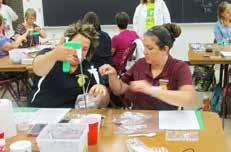
Participants at a GrowNextGen workshop test the protein and carbohydrate levels of homemade soymilk ice cream.
GrowNextGen provides a place for science teachers to find soybean-related bioscience materials; promotes modern, agriculture-related careers to students; and engages teacher leaders in subjectcentered networks such as biotechnology, chemistry, environmental science, agriscience and informal education.
“GrowNextGen was launched in late 2013, and has seen substantial growth since then,” said Bill Bateson, chair of OSC’s Communications/Education committee and soybean farmer from Hancock County. “From an increase in website hits, teachers joining the network and teachers utilizing the material, we expect to see even more growth in 2016.”
GrowNextGen effort has found success in three overarching goals:
Grow the GrowNextGen leadership team
GrowNextGen currently has 39 teacher leaders, with more teachers asking to join this team. GrowNextGen’s teacher leaders develop curriculum, test content and lead workshops. They represent teachers in many different areas — chemistry, environmental science, biology and agriculture — serving as enthusiastic advocates sharing GrowNextGen resources with other teachers around the state. There has been a direct correlation between the events teacher leaders host and the number of users going to the website.
Increase site content, engagement level and ease of use
This year GrowNextGen added 2 new career videos, 5 new e-learning courses, and 11 new curriculum units. The website, GrowNextGen.org saw a 950% increase in users in the second year.
“Based on site user data from the first two months of fiscal year 2016, we expect this year to see a 75% growth over Fiscal year 2015,” said Tom Fontana, Director, Research and Education at OSC. “Our influence is growing as teachers and teacher educators from outside of Ohio and around the U.S. are now accessing our site. GrowNextGen hosted workshops and outreach events reaching 1447 teachers. Those teachers reach an estimated 160,617 students per semester.”
Promote GrowNextGen and increase the project’s reach
When you want to drive growth in site usage and engagement, getting the word out is key. GrowNextGen’s well-rounded strategy encompasses trade shows, special sessions at events, social media, print materials, contests and a monthly e-newsletter. More than 3600 teachers, industry leaders, and students are a part of this educational network.
“GrowNextGen’s reach is everexpanding, and we’re beginning to see signs that the footprint has spread beyond Ohio,” added Bateson. “Other state soybean checkoff organizations are referencing our resources, and collegiate agriculture education programs outside of Ohio are using GrowNextGen to prepare pre-service teachers. Most recently, the organizers of the National Ag in the Classroom initiative asked GrowNextGen to contribute lessons to its matrix of curriculum. We are excited to see what happens in 2016.” u

Soy Transportation Coalition Tours Panama Canal and Re-elects Officers
The Soy Transportation Coalition (STC) reelected its officers and visited one of the most consequential links in the agricultural logistics chain during the organization’s annual meeting December 2nd and 3rd in Panama.
Approximately 100 U.S. soybean farmers and staff members of soybean associations participated in the annual meeting and later toured the Panama Canal and received an update on the canal’s expansion from officials from the Panama Canal Authority.
While in Panama, the group toured the current canal locks on both the Atlantic and Pacific side of the country. In addition, participants were able to view the new expanded canal locks that are scheduled to be open for use in April of 2016.
“It is incumbent upon farmers to not only be knowledgeable of and passionate about the supply and demand side of their industry,” said Mike Steenhoek, executive director of STC. “Farmers must also be knowledgeable of and passionate about the transportation system that allows supply to connect with demand. The Panama Canal — both the current and future expanded canal — is an important artery that allows the U.S.
soybean industry to be so competitive in the international marketplace. Farmers need to understand this key link in our logistics chain, which will hopefully serve to increase our resolve and motivation to demand that our nation appropriately invests in our own transportation system. If we fail to make these investments in our ports, inland waterways, railroads, and roads and bridges, the expanded Panama Canal will truly be a missed opportunity.”
Approximately 600 million bushels of U.S. soybeans annually transit the Panama Canal — the number one U.S. agricultural commodity utilizing the canal. Recent analysis — funded by the soybean checkoff — examined the impact of the Panama Canal expansion on U.S. agriculture. The analysis highlighted that one of the immediate beneficiaries of the expansion will be bulk commodities, like agricultural products.
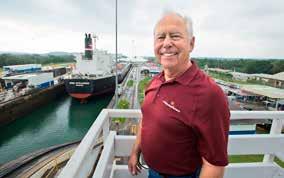
vessel to a 45 foot draft.
During the annual meeting, Scott Gauslow of Colfax, North Dakota, was reelected chairman of the STC.

According to the research, the draw area to the nation’s major navigable waterways could expand from 70 miles to 161 miles. As a result, there will be increased areas of the country that will be able to avail themselves of the inland waterway system. The demand for barge loading facilities along the country’s major rivers will likely increase. The 111 mile line would be the expanded draw area from loading a “Panamax” vessel to a 45 foot draft in Southern Louisiana. The 161 mile line denotes loading a small “Capesize”
“I look forward to continuing to serve as chairman of STC,” said Gauslow. “If U.S. soybean farmers truly want to remain the leading supplier in the global marketplace, we need to have a transportation system that can deliver our growing supply to a growing customer demand. I am pleased to be a part of such an organization that focuses on the modes of transportation farmers rely on to be profitable in a competitive industry.”
Gerry Hayden of Calhoun, Kentucky, was reelected vice chairman and Mike Bellar of Howard, Kansas, was reelected secretary-treasurer.
Patrick Knouff, Ohio Soybean Council board member and soybean farmer from Shelby County previously served as chairman of STC from 2013 to 2014 and was a member of the board of directors since 2008. Currently, Ohio Soybean Council board members Jeff Magyar from Ashtabula County and Gretchen Mossbarger from Ross County serve on STC’s board of directors. u
Bill Bayliss, Ohio Soybean Council board member and soybean farmer from Logan County tours the Panama Canal.
Photos provided by Joseph L. Murphy/Iowa soybean Association

TECH TALK: Diving Into The Age of Digital Agriculture
Ask a farmer what they remember about the 1980s and it is likely to involve some lean financial years, a widespread drought in 1988, and the introduction of the no-till drill. They may recall soybeans planted in 30 inch rows so they were wide enough to cultivate or running a moldboard plow over nearly every acre. There were limited options for herbicides and they probably bought seed and chemicals from a locally owned company, sometimes making the deal in good faith with a handshake.
Mike Estadt, who worked as a student at Ohio State’s Farm Science Review in the early 80s, recalls standing on the nearby highway overpass to scout fields and
decide which patch of weeds they would need to chop out of the fields. Today, farmers can send up a drone or UAV (Unmanned Aerial Vehicle) that will not only allow them to locate noxious weeds at an earlier growth stage, but can collect data to enhance nutrient management and other production practices on their farm.
“We never would have dreamt where we have come in 30 years,” said Estadt, who now works as an Ohio State University Extension Agent in Pickaway County. “During grad school in 1989, I remember buying a computer for around $3,000 with a student discount. My cell phone today cost less and can do more than that computer could do.”
New technology in the last 30 years has brought us yield monitors, auto-steer in tractors, variable rate application of chemicals, multiple points of data collection and most recently, precision planting that will allow two hybrids to be placed automatically in one field. Farmers check the forecast on their cell phones and sign contracts on the screen of a salesman’s tablet. The industry has come a long way in just a few decades.
“In the last ten years, technology has been more widely adopted because farmers have had the money to do it,” said Estadt. “Farmers that have adopted
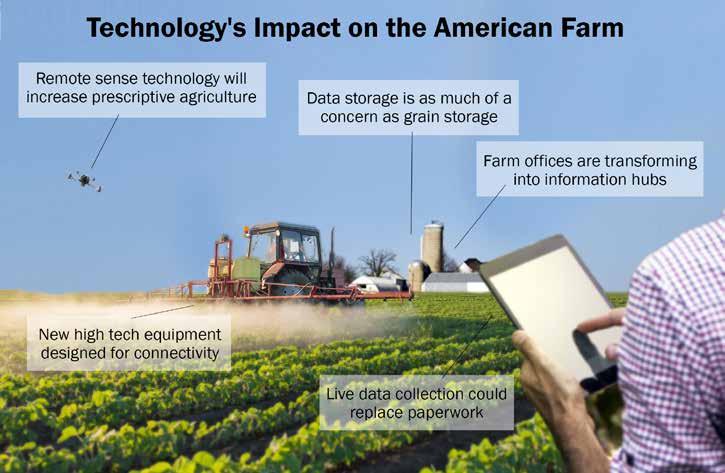
the new technology know their numbers and the true cost of production. They’re trying to fine tune it and find efficiency.”
What will a farm look like in another 30 years?
Will mobile soil testing allow farmers to make more informed decisions on what crop varieties would perform the best? Perhaps a driverless sprayer will enter a field and launch a UAV to analyze the plants and send messages back that adjust the content, concentration and application rate of the mixture. Maybe harvest is completed with several smaller machines working parallel to the main machine; each equipped with remote sensors to make adjustments based on changing field conditions. Those ideas may not be too far off, and it’s highly likely that in 30 years the agriculture industry may be capable of much more.
“I think we’re on a trajectory of what I describe as digital agriculture,” said John Fulton, a precision ag research and extension specialist at The Ohio State University. “Think about precision ag, we spent 20 years getting technology integrated into a lot of our farms and now we’re really exploring the data piece of that.”
As precision ag capabilities are more fully integrated a farmer can begin to identify opportunity and cost on a field by field level as opposed to an enterprise level of management. To find those opportunities, someone has to sift through the tremendous amount of data being collected. Fulton breaks the data down to three basic types: Agronomy data, such as yield; Machine data, such as location and fuel consumption; and Remote Sense Imagery, such as vegetation density data collected by UAVs.
“The data is getting a lot of attention in the ag industry, but we also realize that growers need to be looking at best management practices to create the most accurate data for them to submit to some of these services that can give them the best recommendations, or prescriptions,” said Fulton.
The biggest source of error Fulton sees in data collection is getting it off the machine without compromising or losing the data. While connectivity is

growing, it will take some time to get to the point of being able to wirelessly transfer all of the data from the equipment in the field directly to the cloud, especially in the most rural areas. Along with connectivity and cloud storage comes more concern from growers with Fulton acknowledging more than 65 percent of growers being concerned about data privacy and security.
“As an industry we’re trying to get better legal documents in place because when we start talking data it becomes about connectivity, cloud technology, who has access, who can take advantage of it and who can utilize that data,” said Fulton.
These changes also create a demand for a high tech work force. Ohio State currently has a few classes that explore these areas and how to handle and organize data, but Fulton sees that expanding to a suite of courses that would dig deeper.
“I see a higher need for students having a background in and not only identifying with the technology, but dealing with quality, set-up, calibration and understanding all the bits and pieces. Data is one thing, but you have to have the agronomy and economics and even tech background to make it work for a grower,” said Fulton. u
About TechTalks:
The Ohio Soybean Council (OSC) recognizes that these new technologies provide additional opportunity and concern for growers. Therefore, OSC conducted in-depth research on the current state of digital communication in rural Ohio. Over the next year, OSC’s TechTalk series will take a closer look at issues that are important to you and the future of the industry. Future topics include:
▶ Data storage options and their compatibility and privacy controls
▶ Cell phone coverage / wireless access in rural areas and the use of tablets in agriculture
▶ Broadband coverage and the impact of download and upload speeds on ease of use
▶ Training for growers and a workforce to fill new in-demand positions, as well as unbiased sources to assist with informed decisions
▶ Use of robotics, remote sensing and UAVs in agriculture
It’s an exciting time to be involved in agriculture and see what develops in the next 30 years to feed an ever-growing population and satisfy a changing consumer demand.



“We’ve been planting Seed Consultants for a few years and have found with their service, seed quality and product performance; they are the Best Value in the Seed Industry.”
“Seed Consultants yield performance, service and farmer-friendly pricing is why we’ve been planting Seed Consultants for the past six years.”
“I’ve had great success planting Seed Consultants. The highest-yields on my farm have been from their corn and soybean varieties.”
Titus Michael, Clinton County, Indiana
Hugh Boles Farms, Onton, Kentucky
Doug Franck, St. Henry, Ohio
